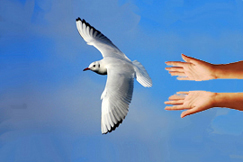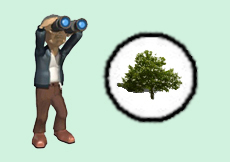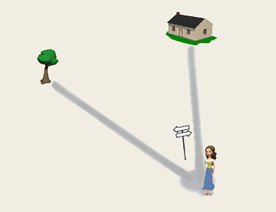STEP 7
Vocabulary
![]() Read and memorize this nouns and adjectives.
Read and memorize this nouns and adjectives.
Nouns
Apple |
 |
Bird |
 |
Branch |
 |
Fruit |
 |
Garden |
 |
Grass |
 |
Tree |
 |
End |
|
Keep |
|
Let |
Adjectives
Acid
Ready
Red - Green
Sweet - Bitter
Structure words
Keep |
Who | No |
Let |
Near - Far | If |
Seem |
Almost | |
About |
Quite | |
Up - Down |
All | |
You |
Every |
Structure
- Nouns
Nouns naming objects taken together as a mass or a group are treated like names of substances. We have two such 'collective' nouns in this Step, “grass” and “fruit”.
- Some fruit is on the tree.
- Grass is green.
- Adjectives of Quantity
These may now be looked at as a group. In Step 5, you learned some. We come in this Step to “no”, “all” and “every”.
Like all non-descriptive adjectives, adjectives of quantity preceded descriptive adjectives before a noun.
Like some, none of the adjectives of quantity given here can be preceded by “a” or a pointing or possessive adjective.
“All” is, however, an exception to the general rule by which “a”, “the”, and the pointing and possessive adjectives come before all other adjectives qualifying the same noun, and it may be used with any of these following it except a(n).
“All” is used to indicate the total number or amount taken together. All is used with both names of substances and names of things, the latter being in the plural (apart from the exception noted below).
- All grass is green
- All trains go to stations.
“The” or a “possessive” or “pointing” adjective (or pronoun) used after all indicates that the total is only of the particular group or amount being referred to, not of the things named in general.
- All the potatoes in the garden are small.
- All these trains go from there to London.
- All my food is here.
- All that is green.
When followed by the, etc., all may qualify the name of a countable in the singular, in the sense of 'the whole of'.
- I will not give all the apple to my brother.
Like some, all has a pronoun use.
- She has some potatoes in her garden but all are small.
- He will keep all of these.
There is no difference between “all these” and “all of these”; they are merely alternative expressions. The only case in which of is necessary after all is before a personal pronoun.
- All of them (never ALL they) are here.
- He will take all of them (never all them) into the garden.
“Every” is also used to indicate the total number of the things named, but in contrast with “all”, it makes us think of them one by one. Therefore, like “a”, it only goes with singular nouns, and, when used with names of substances, its sense is 'every sort of'.
- Every tree has branches.
- Every food in the picture is sweet.
“No” has the sense 'not any amount of' or 'not any number of, not one,' and so its uses are parallel to those of both all and every. It makes no difference to the sense whether we say no man ('not one man') or no men ('not any men').
- No married man will do the work.
- I take no apples from this tree.
- No grass is red.
Note that a sentence with no may take the place of a negative formed with not.
- I take no apples from this tree: I do not take apples from this tree.
- I have no table in my room: I have not a table in my room.
You have learned “some” as the adjective of indefinite amount. A very common use brings out the contrast (which we have already seen implied in the pronoun) between the things, etc., singled out by some and other things of the same sort.
- Some apples are read. (But not all).
- Some buildings have no garden.
“Some” has also a more distinct further sense as '(a) particular but unidentified', in which it can com before a singular noun naming a countable.
- Some woman is in the garden. (That is, 'a woman, I don't know who')
- Pronouns
The Plural of the Second Person are the same.
- You are his mother, and you are his father.
- You have no other sons.
- Your son is in your house. He is with you.
- My (brother | sister | sister and brother) and I will go into the garden.
- We will give some food to the birds.
- The birds come to us and take the food from our hands.
Root Form |
Form for Subjects |
Form for Objects |
Possessive Adjective |
Singular |
WHO |
WHO(M)1 |
WHOSE |
and |
|||
Plural |
|||
S & P |
WHICH |
WHICH |
|
S & P |
WHAT |
WHAT |
|
1 With certain exceptions which will be dealt with later, who is generally used instead of whom in talk and informal writing. |
The Table above gives the forms of the relative pronoun, which acts as a pronoun and a conjunction at the same time. It is used after a noun or pronoun to introduce a statement giving an identifying or supplementary description2 of what is name by it. A relative pronoun may be the subject or the object of the descriptive statement or the object of a preposition in it, but whatever part it plays in the statement, it always come at the beginning.
In this Step, we are concerned only with “who” and “which”. You will note that these are both singular and plural.
“Who” is used for persons (male or female) and which are animals and things.
- The married son is not here.
The son who is married is not here.
- I will take the book to my mother. She is in the garden.
I will take the book to my mother, who is in the garden.
- Some food is on the table for the men, who seem ready for it.
- She is the woman who(m) I may get for the work.
- The friends who(m) we will give the fruit to are in the garden.
- The bird which takes the fruit is on that branch.
- You may take the apples which are on the grass.
- This fruit which I have in my hand is for my brother.
- He is by the branch which the bird is on.
The singular pronoun “that” has a special use before which in the quite general sense of 'the thing' or 'a thing', with no reference to anything previously mentioned.
- You may do that which I do.
In the same way, the plural “those” may be used before “who” in the sense of '(the) persons'.
- Those who give to others have friends.
The possessive adjective “whose”, given in the Table for persons, may also be used for things. Like the other relative forms, it is placed at the beginning of the statement, followed by the noun it qualifies, no matter whether this is subject or object.
- The man whose hand is in his pocket is my brother.
- I will give these apples to the friend whose books you have.
- W will take the frit from the tree whose branches the birds are on.
- My father, whose office is in the town, will get the book for me.
2 When a statement introduced by a relative is not necessary to the identification of that object, it has a comma before it (and after it if the sentence continues
- Operators
Root Form |
Present |
Past |
Future |
KEEP |
KEEP |
KEPT |
WILL KEEP |
but, he, she, it, etc. KEEPS |
|||
LET |
LET |
LET |
WILL LET |
but, he, she, it, etc. LETS |
|||
SEEM |
SEEM |
SEEMED |
WILL SEEM |
but, he, she, it, etc. SEEMS |
As you will see, the Present and Future forms of these three new operators are quite regular. We are not concerned with the Past forms in this Step.
“Keep” has the sense of having, possibly forever, and not letting others have.
- We keep all the fruit which we get from our garden.
- He keeps the food for the birds.
- She will keep his picture.
The root sense of “let” is 'put nothing in the way of the action or behavior of some person or thing', which ranges from mere non-interference to the actual giving of permission. This makes it natural for it to be followed by a noun or pronoun and an operator. The word naming the person or thing whose action is permitted comes straight after let (in the form for the object in the case of a pronoun) followed by the root form of the operator naming the action, etc.
- They let the birds take the fruit.
- The manager lets us go when the other go.
- The woman who has the small son will not let him take the pot off the fire.
“Seem”, like be, is an operator which does not represent an action. In its simplest use, seem is followed by an adjective. (But for more information see Step 19)
- The birds on that great branch seem small.
- The train seems slow.
- The house will seem full when the family comes in from work.
- Prepositions
Three more prepositions come into this Step.
- The flowers in the grass about the tree are white.
- He goes up this side of the wall and down the other side.
“Up” and “down” are also used adverbially.
- I put my hand up.
We have noted the use of “to” after give. This is an instance of the general rule that the person or thing to which an act, etc., is directed (the 'indirect object'), or in relation to which a condition is asserted, is preceded by “to”.
- He will not do that to you.
- She is married to the man.
- These apples seem sweet to me, but they seem acid to John.
- Adverbs
- ORDER
When two or more adverbs or adverbial phrases follow an operator, their order cannot be reduced to exact rules, and the student must depend largely on careful observation. One general principle, however, may be given for his guidance: Always put the adverb, etc., most necessary to the sense of the operator before any other.
- We will go in from the garden.
The rule already given said that adverbs of time follow adverbs of lace, is a special instance of this general principle.
“Near” and “far” indicate the position of one thing in relation to another. When it is desired to put in the name of that in relation to which something is near or far, we put a preposition after the adverb and say near to3 or far from.
- When the bird at the end of the branch come near, but may take some food from my hand.
- I will put this near to the other trees.
- My father does not go far at night.
- The train takes him far from his friend.
3 It will be seen in Step 10, however, that near also has a prepositional use.
- ADVERBS OF DEGREE
The adverbs of degree “almost” and “quite” go with adjectives, adverbs, and operators. They precede these but follow an auxiliary.
- The meal is almost ready.
- It will be quite ready when you come.
- The train is almost full.
- The train is not quite full.
- The boy almost gets the bird.
- The bird will go before she quite gets it.
- He will almost do the work.
- I may not quite do the work.
- Conjunctions
“If”, introduces a dependent statement qualifying the main statement by a condition. The dependent statement may come before or after the main statement. This may be taken as applying to adverbial dependent statements generally except where it is made clear that no alternative position is possible.
- The birds take the fruit if it is sweet.
- If it is bitter or acid, they do not take it.
When the condition refers to the future, the dependent statement is still put in the Present Tense, even though the main statement is in the Future Tense.
- If you go into the garden, I will go with you.
Exercises


- (a) Describe what you see in the first picture in two different ways, first using let and then keep.
(b) Describe what the tree in the second picture seems to the man and what it is.
A:
- Fill in the blanks with an adjective of amount.
(a) _____ father is a man
(b) _____ trees have branches.
(c) _____ mothers are men.
(d) _____ gardens have trees.
(e) _____ the fruit is on the grass.
(f) _____ grass is white.
(g) _____ fruit is bitter.
- Fill in the blanks with a relative form.
(a) The apples _____ are on the tree are sweet.
(b) I will go to the man _____ son is on the branch.
(c) That is the friend _____ I will give the apples to.
(d) He comes from the house _____ garden these threes are in.
(e) The apples _____ we will give to you, are in the bag.


- Describe the condition of these pots, using an adverb of degree in connection with each.
- Write two if-statements concerning the alternative directions that the woman may take and what she will come to in each case.




